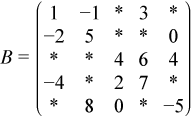Direct sparse solvers can also solve symmetrically structured systems of equations. A symmetrically structured system of equations is one where the pattern of non-zero elements is symmetric. That is, a matrix has a symmetric structure if aj,i is not zero if and only if ai, j is not zero. From the point of view of the solver software, a "non-zero" element of a matrix is any element stored in the values array, even if its value is equal to 0. In that sense, any non-symmetric matrix can be turned into a symmetrically structured matrix by carefully adding zeros to the values array. For example, the above matrix B can be turned into a symmetrically structured matrix by adding two non-zero entries:

The matrix B can be considered to be symmetrically structured with 15 non-zero elements and represented as:
| one-based indexing | ||||||||||||||||
| values | = | (1 | -1 | -3 | -2 | 5 | 0 | 4 | 6 | 4 | -4 | 2 | 7 | 8 | 0 | -5) |
| columns | = | (1 | 2 | 4 | 1 | 2 | 5 | 3 | 4 | 5 | 1 | 3 | 4 | 2 | 3 | 5) |
| rowIndex | = | (1 | 4 | 7 | 10 | 13 | 16) | |||||||||
| zero-based indexing | ||||||||||||||||
| values | = | (1 | -1 | -3 | -2 | 5 | 0 | 4 | 6 | 4 | -4 | 2 | 7 | 8 | 0 | -5) |
| columns | = | (0 | 1 | 3 | 0 | 1 | 4 | 2 | 3 | 4 | 0 | 2 | 3 | 1 | 2 | 4) |
| rowIndex | = | (0 | 3 | 6 | 9 | 12 | 15) |
Storage Format Restrictions
The storage format for the sparse solver must conform to two important restrictions:
the non-zero values in a given row must be placed into the values array in the order in which they occur in the row (from left to right);
no diagonal element can be omitted from the values array for any symmetric or structurally symmetric matrix.
The second restriction implies that if symmetric or structurally symmetric matrices have zero diagonal elements, then they must be explicitly represented in the values array.